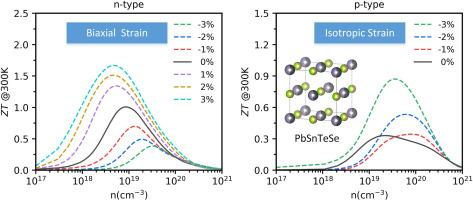当前位置:
X-MOL 学术
›
Mater. Today Phys.
›
论文详情
Our official English website, www.x-mol.net, welcomes your
feedback! (Note: you will need to create a separate account there.)
Influence of biaxial and isotropic strain on the thermoelectric performance of PbSnTeSe high-entropy alloy: A density-functional theory study
Materials Today Physics ( IF 10.0 ) Pub Date : 2024-11-08 , DOI: 10.1016/j.mtphys.2024.101590 Ming Xia, Pascal Boulet, Marie-Christine Record
Materials Today Physics ( IF 10.0 ) Pub Date : 2024-11-08 , DOI: 10.1016/j.mtphys.2024.101590 Ming Xia, Pascal Boulet, Marie-Christine Record

|
Strain engineering is an effective method to improve materials thermoelectric (TE) performance. In this study, both biaxial and isotropic strains ranging from −3% to +3 % and from −3% to −1%, respectively, were applied to improve the TE properties of PbSnTeSe high entropy alloy (HEA). The effects of strain on the TE transport properties of PbSnTeSe HEA were investigated using first-principles calculations combined with Boltzmann transport theory. Under biaxial strain, n-type doped PbSnTeSe HEA shows an increase in the optimal power factor (P F P F P F 2 for n-type and 0.85–1.3 mW/mK2 for p-type doped PbSnTeSe HEA. The maximum figure of merit (Z T Z T P F 2 for n-type and from 1.1 to 3.4 mW/mK2 for p-type doped PbSnTeSe HEA. Additionally, isotropic strain boosts the maximum Z T
中文翻译:

双轴应变和各向同性应变对 PbSnTeSe 高熵合金热电性能的影响:密度泛函理论研究
应变工程是提高材料热电 (TE) 性能的有效方法。在本研究中,分别应用了 -3% 至 +3 % 和 -3% 至 -1% 的双轴和各向同性应变来改善 PbSnTeSe 高熵合金 (HEA) 的 TE 性能。使用第一性原理计算结合玻尔兹曼输运理论研究了应变对 PbSnTeSe HEA 的 TE 输运特性的影响。在双轴应变下,n 型掺杂的 PbSnTeSe HEA 在压缩应变和拉伸应变下均显示出最佳功率因数 (PF) 的增加。对于 p 型掺杂,压缩应变增强 PF,而拉伸应变降低 PF。在 −3% 至 +3 % 的应变范围内,n 型的最佳 PF 为 7.8–9.5 mW/mK2,p 型掺杂 PbSnTeSe HEA 的最佳 PF 为 0.85–1.3 mW/mK2。在 300 K 下,在 3% 拉伸应变下,n 型掺杂 PbSnTeSe HEA 的最大品质因数 (ZT) 值为 1.63,比无应变的 ZT 值 1.1 高 61%。在 0 % 到 -3% 的各向同性应变范围内,n 型的 PF 从 7.8 增加到 14 mW/mK2,p 型掺杂的 PbSnTeSe HEA 从 1.1 增加到 3.4 mW/mK2。此外,在 -3% 应变下,各向同性应变在 300 K 时将 p 型掺杂 PbSnTeSe HEA 的最大 ZT 值从 0.3 提高到 0.85。本研究证实,应变工程是增强 PbSnTeSe HEA 热电性能的有效策略。
更新日期:2024-11-08
中文翻译:

双轴应变和各向同性应变对 PbSnTeSe 高熵合金热电性能的影响:密度泛函理论研究
应变工程是提高材料热电 (TE) 性能的有效方法。在本研究中,分别应用了 -3% 至 +3 % 和 -3% 至 -1% 的双轴和各向同性应变来改善 PbSnTeSe 高熵合金 (HEA) 的 TE 性能。使用第一性原理计算结合玻尔兹曼输运理论研究了应变对 PbSnTeSe HEA 的 TE 输运特性的影响。在双轴应变下,n 型掺杂的 PbSnTeSe HEA 在压缩应变和拉伸应变下均显示出最佳功率因数 (PF) 的增加。对于 p 型掺杂,压缩应变增强 PF,而拉伸应变降低 PF。在 −3% 至 +3 % 的应变范围内,n 型的最佳 PF 为 7.8–9.5 mW/mK2,p 型掺杂 PbSnTeSe HEA 的最佳 PF 为 0.85–1.3 mW/mK2。在 300 K 下,在 3% 拉伸应变下,n 型掺杂 PbSnTeSe HEA 的最大品质因数 (ZT) 值为 1.63,比无应变的 ZT 值 1.1 高 61%。在 0 % 到 -3% 的各向同性应变范围内,n 型的 PF 从 7.8 增加到 14 mW/mK2,p 型掺杂的 PbSnTeSe HEA 从 1.1 增加到 3.4 mW/mK2。此外,在 -3% 应变下,各向同性应变在 300 K 时将 p 型掺杂 PbSnTeSe HEA 的最大 ZT 值从 0.3 提高到 0.85。本研究证实,应变工程是增强 PbSnTeSe HEA 热电性能的有效策略。

































 京公网安备 11010802027423号
京公网安备 11010802027423号